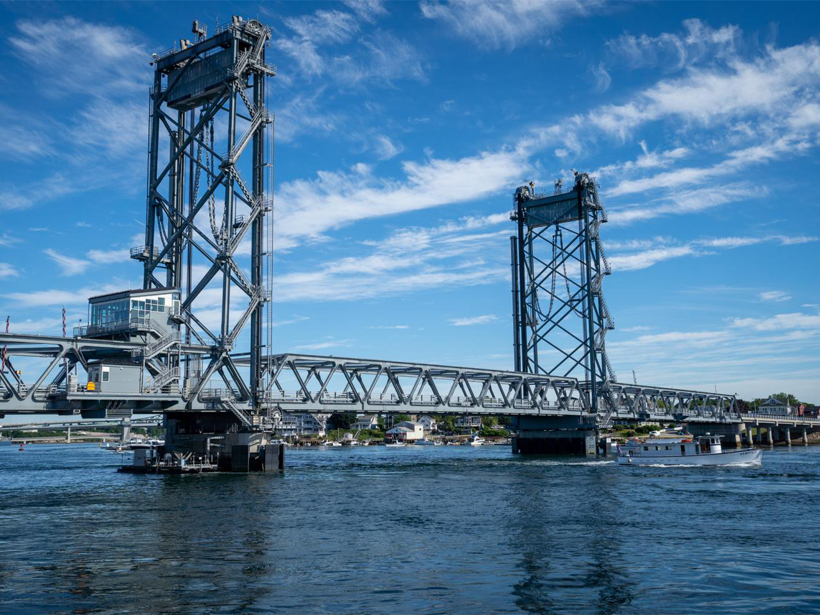The Memorial Bridge spanning the Piscataqua River from Portsmouth, N.H., to Kittery, Maine, is equipped with a suite of technologies that makes it unlike any other bridge in the world. It has a tidal turbine and associated deployment platform, two weather stations, and structural, environmental, and marine data sensor suites, said Erin Bell, a professor of civil engineering at the University of New Hampshire and principal investigator on the project.
It’s the focus of the Living Bridge project, which aims to show a glimpse of what tomorrow’s smart transportation systems might look like.
“Our transportation infrastructure is a huge cost, and it can do more than get us from A to B.”
“Our transportation infrastructure is a huge cost, and it can do more than get us from A to B,” Bell said.
Rather than serving just as a means of traversing the Piscataqua River, this “living” laboratory uses acoustic Doppler current profilers to study the river’s currents. A conductivity, temperature, and depth sensor is in use, and in addition to providing those types of data, the sensor also measures the water’s turbidity and the amount of dissolved oxygen and chlorophyll present in it. The bridge’s weather stations provide wind speed, humidity, and temperature data. The structural sensors enable Bell and her colleagues to obtain six to eight “really nice…stress tests” of the vertical-lift bridge every day, she said.

Tidal energy “is the next generation global engineering technology following wind and solar,” said Vincent Neary, who leads Sandia National Laboratories’ marine and hydrokinetic technologies research and development projects and isn’t involved with the project.
“What is exciting about this is that tidal energy can be very predictable,” said Martin Wosnik, associate professor of mechanical engineering at the University of New Hampshire in Durham, who was the lead on the Living Bridge turbine install. “Unlike solar panels, which can be unreliable due to cloudy days or bad weather, tidal energy is more stable because we can predict the tides well into the future.”
The bridge’s inclusion of the tidal turbine is both unusual and remarkable because “it’s not an easy thing to do, to put a tidal turbine on a bridge,” Bell said. Bridge construction budgets are typically tight, so incorporating this type of renewable energy often seems outside of the scope of these projects, she noted.
A Multiuse, Multibenefit Bridge
The Living Bridge project aligns well with “a big push” in civil engineering for “multiuse, multibenefit projects.”
Neary and Bell agree that the key to moving forward with projects such as this lies in demonstrating that the benefits of integrating the tidal energy and other technologies outweigh the associated costs. The Living Bridge project aligns well with “a big push” in civil engineering for “multiuse, multibenefit projects,” Neary noted.
This project also has tremendous educational value. Middle and high school teachers have used data from the bridge in classroom-based citizen science projects, Bell said. She has also spoken to retirement communities about the project, shown scale models of the turbine to 120 seventh grade students who have visited the laboratory, discussed the project at public meetings, and explained the instrumentation on science cruises of the Portsmouth Harbor.
The bridge is “exciting and innovative enough that folks can learn something from it, whether they’re in kindergarten or in their 80s,” Bell noted.
Neary “loves” the educational component of the project because “a lot of our population isn’t connected with science and understanding the importance of fact-based and data-based decision-making,” and having the opportunity to engage with this or similar projects might change that.
Bell is often asked whether the presence of the sensors and other instrumentation signifies that something is wrong with the bridge, but it’s actually quite the opposite: The team saw the opportunity to make the bridge a “living” construction when the bridge structure that preceded it had to be closed and replaced (except for the piers) because of structural deficiencies, she said.
Both Bell and Neary could see a place for similar smart bridges in other communities. Bell said that aside from securing funding, it’s critical that others who want to embark on similar projects are able to demonstrate to the bridge owners how the project will add value for them, not just the researchers.
Neary thinks there are potentially hundreds of places in the United States alone where it might make sense to do similar projects. In an ideal world, he said, “every single bridge should be evaluated” by asking “Can we have a project here?”
However, “you need money to do it right,” he said, and political barriers often get in the way of funding infrastructure.
—Rachel Crowell (@writesRCrowell), Science Journalist
Citation:
Crowell, R. (2019), This bridge monitors the environment and harnesses tidal energy, Eos, 100, https://doi.org/10.1029/2019EO130389. Published on 07 August 2019.
Text © 2019. The authors. CC BY-NC-ND 3.0
Except where otherwise noted, images are subject to copyright. Any reuse without express permission from the copyright owner is prohibited.

